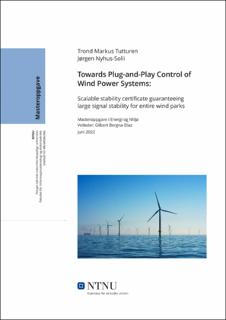| dc.description.abstract | For å redusere den global oppvarming må kraftproduksjonen gå over fra fossile kilder til fornybare
energikilder med lavere karbonavtrykk. Det tradisjonelle strømnettet består av store fossildre-
vne kraftverk som ofte plassert i nærheten av det største kraftforbruket, f.eks. nær storbyer.
Overgangen til fornybare energikilder byr på nye utfordringer. De fornybare energikildene vil
sporadisk bli integrert i kraftnettet, potensielt langt unna der det meste av kraften forbrukes,
noe som forårsaker mindre forutsigbar kraftproduksjon og mer utfordrende kraftoverføring. Der
tradisjonell kraftproduksjon domineres av store synkrongeneratorer med stort treghetsmoment, er
de fleste fornybare energikilder koblet til kraftnettet gjennom kraftelektroniske omformere hvor
treghetsmomentet ikke kan bidra til stabiliteten regulering i kraftnettet. Den økende innfasingen
av fornybar energi har derfor potensialet til å redusere og i verste fall ødelegge stabiliteten og
kraftoverføringsevnen til hele kraftsystemet. Derfor er det nødvendig med en ny strategi for å kon-
trollere kraftelektroniske omformere som muliggjør en kontinuerlig vekst av distribuerte fornybare
energikilder uten at det går på bekostning a stabiliteten i kraftsystemet.
En av disse omformertilkoblede fornybare energikildene er vindkraft, som kan bli en av de største
kildene til elektrisk energu i fremtiden. Denne masteroppgaven har som mål å utvikle et skalerbart
stabilitetssertifikat som åpner for en plug-and-play-filosofi for en vindpark. Med skalerbart sta-
bilitetssertifikat menes det som et sett med kriterier som garanterer stor signalstabilitet for en
vindpark som kan bygges ut til ønsket størrelse og kobles til eksternt strømnett uten risiko for
ustabilitet. plug-and-play-funksjonen er ment som en tilkoblingsstrategi som gjør det mulig for
et system å tilpasse seg endringer med minimale inngrep. Utledningen av stabilitetssertifikatet er
basert på en analyse av et vinkraftsystem bestående av en permanent magnet synkrongenerator
koblet til fullskala back-to-back to-nivå spenningskildeomformere. Systemet introduserer tre ut-
fordrende ulineæriteter: i generatordynamikken, det mekaniske dreiemomentet som genereres av
vinden, og i kraftomformerne. Det vises hvordan et slikt vindkraftsystem kan garanteres å være
stabilt for store forstyrrelser ved å bruke designkriterier for dempingen i generatoren og regulering-
skrav for passivitetsbaserte tilbakekoblingskontrollsløyfer. Det er bevist at ved å tilfredsstille disse
stabilitetskriteriene lokalt ved hver vindturbin vil en vindpark bestående av disse vindturbinene
også være garantert stabil for store forstyrrelser. Derved er et skalerbart stabilitetssertifikat funnet.
Utledningen av stabilitetskriteriene er basert på følgende verktøy fra ulineær systemteori. Passivity
brukes som utgangspunkt for kontrolldesign i kombinasjon med port-Hamiltonian modellering.
Lyapunovs direkte metode brukes for stabilitetsanalysen, der Lyapunov-kandidatfunksjonen velges
basert på energien i systemet. Til slutt brukes grafteori for å utvide modellen fra én vindturbin til
en vindpark for å undersøke stabiliteten til et helt system.
I tillegg, sammenligner denne oppgaven i korthet PI-strømkontroll med PI-PBC, ytelses- og sta-
bilitetsutfordringene med og uten kaskadekontrollstruktur, og hvordan dempingen i generatoren
forbedrer kontrollytelsen. | |
| dc.description.abstract | To reduce global warming, power generation must transition from fossil sources to renewable
energy sources with a lower carbon footprint. The traditional power grid structure is comprised
of large fossil-fueled power plants often located in the vicinity of the power consumption, such as
big cities. The transition to distributed renewable energy sources introduces new challenges. The
renewables will be intermittently integrated into the power grid, potentially far away from where
most of the power is consumed, causing less predictable power generation and more challenging
transmission. Where traditional power generation is dominated by large synchronous generators
with large inertia, most renewable energy sources are connected to the power grid through power
electronic converters where the inertia cannot contribute to the stability of the power grid. The
increasing penetration of renewables, therefore, has the potential to jeopardize the stability and the
performance of the entire power system. Therefore, a new strategy for controlling power electronic
converters is needed that allows for the continuous growth of distributed renewable energy sources
without compromising the stability of the power system.
One of these converter-connected renewable energy sources is wind power, which might become
one of the largest power sources in the future. This master thesis aims to develop a scalable
stability certificate allowing for a plug-and-play philosophy for a wind park. By scalable stability
certificate, it is meant as a set of criteria that guarantee large signal stability for a wind park that
can be expanded to the desired size and connected to an external power grid without the risk of
instability. The plug-and-play feature is meant as an connection strategy which enables a system
to adapt to changes with minimal interventions. The derivation of the stability certificate is based
on an analysis of a wind energy conversion system consisting of a permanent magnet synchronous
generator connected to full scale back-to-back two-level voltage source converters. The system
introduces three challenging non-linearities: in the generator dynamics, the mechanical torque
generated by the wind, and in the power converters. It is shown how such a wind energy conversion
system can be guaranteed to be stable for large disturbances by using design criteria for the damping
in the generator and tuning conditions for passivity-based feedback control loops. It is proven that
by satisfying these stability criteria locally at each wind turbine, a wind park consisting of these
wind turbines will also be guaranteed to be stable for large disturbances. Thereby, a scalable
stability certificate is found.
The derivation of the stability criteria relies on the following tools from non-linear system theory.
Passivity is used as a starting point for control design in combination with port-Hamiltonian
modeling formalism, which emphasizes the system dissipation, interconnection pattern, and the
energy in the system dynamics. Lyapunovs direct method is used for the stability analysis, where
the Lyapunov candidate function is inspired by the energy of the system. Lastly, graph theory is
used to expand the model from one wind turbine to a wind park to investigate the stability of the
entire system.
In addition, this thesis briefly compares PI-current control with PI-PBC, the performance and
stability challenges with and without cascaded control structure, and how the damping in the
generator improves the control performance. | |
